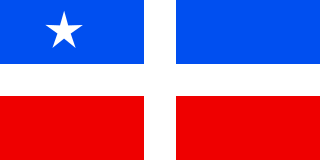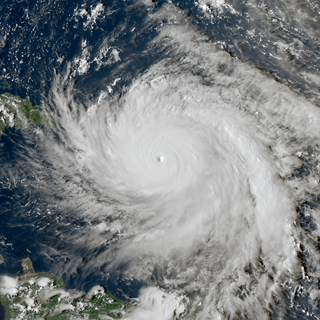
Puerto Rico, officially the Commonwealth of Puerto Rico and briefly called Porto Rico, is an unincorporated territory of the United States located in the northeast Caribbean Sea, approximately 1,000 miles (1,600 km) southeast of Miami, Florida.

San Juan is the capital and most populous municipality in the Commonwealth of Puerto Rico, an unincorporated territory of the United States. As of the 2010 census, it is the 46th-largest city under the jurisdiction of the United States, with a population of 395,326. San Juan was founded by Spanish colonists in 1521, who called it Ciudad de Puerto Rico. Puerto Rico's capital is the third oldest European-established capital city in the Americas, after Santo Domingo, in the Dominican Republic, founded in 1496 and Panama City, in Panama, founded in 1519. Several historical buildings are located in San Juan; among the most notable are the city's former defensive forts, Fort San Felipe del Morro and Fort San Cristóbal, and La Fortaleza, the oldest executive mansion in continuous use in the Americas.

Puerto Ricans are people of ethnic origins in Puerto Rico, the inhabitants, and citizens of the Commonwealth of Puerto Rico, and their descendants. Puerto Rico is home to people of many different national origins as well.

Ponce is both a city and a municipality on the southern coast of Puerto Rico. The city is the seat of the municipal government.
The municipalities of Puerto Rico number seventy-eight incorporated towns and cities. Each municipality is led by a mayor and divided into barrios, though the latter are not vested with any political authority. Every municipality is governed by the Autonomous Municipalities Act of 1991 which establishes that every municipality must have a strong mayor with a municipal legislature. Furthermore, each legislature must be unicameral with its number of members varying according to the municipality's population. And, in contrast to other jurisdictions, both the mayors and the municipal legislators are elected on the same date for the same period of time.

Territories of the United States are sub-national administrative divisions overseen by the federal government. They differ from U.S. states and Native American tribes, which have limited sovereignty. The territories are classified by incorporation and whether they have an "organized" government through an organic act passed by Congress.
In the terminology of the United States insular areas, a Commonwealth is a type of organized but unincorporated dependent territory. There are currently two United States insular areas with the status of commonwealth, the Northern Mariana Islands and Puerto Rico.

The Independence Movement in Puerto Rico refers to initiatives by inhabitants throughout the history of Puerto Rico to obtain full political independence for the island nation. First from the Spanish Empire, from 1493 to 1898 and since 1898, from the United States. A wide variety of groups, movements, political parties, and organizations have worked for Puerto Rican Independence over the centuries.

The Senate of Puerto Rico is the upper house of the Legislative Assembly of Puerto Rico, the territorial legislature of Puerto Rico. The Senate, together with the House of Representatives of Puerto Rico, control the legislative branch of the government of Puerto Rico.

The Supreme Court of Puerto Rico —Spanish: Tribunal Supremo de Puerto Rico (TSPR)— is the highest court of Puerto Rico, having judicial authority to interpret and decide questions of Puerto Rican law. The Court is analogous to one of the state supreme courts of the states of the United States; being the Supreme Court of Puerto Rico the highest state court and the court of last resort in Puerto Rico. Article V of the Constitution of Puerto Rico vests the judicial power in the Supreme Court—which by its nature forms the judicial branch of the government of Puerto Rico. The Supreme Court holds its sessions in San Juan.
The Puerto Rico national football team is governed by the Federación Puertorriqueña de Fútbol (FPF). Puerto Rico's national football team is a member of the Caribbean Football Union and part of CONCACAF.
This is a list of properties and historic districts that are listed on the National Register of Historic Places (NRHP) in Puerto Rico. There are 345 NRHP listings in Puerto Rico, with one or more NRHP listings in each of Puerto Rico's 78 municipalities.

The history of Puerto Ricans of African descent begins with free African men, known as libertos, who accompanied the Spanish Conquistadors in the invasion of the island. The Spaniards enslaved the Taínos, many of whom died as a result of new infectious diseases and the Spaniards' oppressive colonization efforts. Spain's royal government needed laborers and began to rely on slavery to staff their mining and fort-building operations. The Crown authorized importing enslaved West Africans. As a result, the majority of the African peoples who entered Puerto Rico were part of the forced migration of the Atlantic slave trade, and came from many different cultures and peoples of the African continent.

The following outline is provided as an overview of and topical guide to Puerto Rico:

The history of Puerto Rico began with the settlement of the archipelago of Puerto Rico by the Ortoiroid people between 3,000 and 2,000 BC. Other tribes, such as the Saladoid and Arawak Native Puerto Ricans, populated the island between 430 BC and 1000 AD. At the time of Christopher Columbus's arrival in the New World in 1493, the dominant indigenous culture was that of the Taínos. The Taíno people's numbers went dangerously low during the later half of the 16th century because of new infectious diseases carried by Europeans, exploitation by Spanish settlers, and warfare.

The political status of Puerto Rico is that of an unincorporated territory of the United States. As such, the island is neither a sovereign nation nor a U.S. state. Because of that ambiguity, the territory, as a polity, lacks certain rights but enjoys certain benefits that other polities have or lack. For instance, in contrast to sovereign nations, Puerto Rico does not have voting rights in its federal legislature nor in electing its federal head of government. But, in contrast to U.S. states, residents of Puerto Rico are not subject to federal income taxes. The political status of the island thus stems from how different Puerto Rico is politically from sovereign nations and from U.S. states.

The barrios of Puerto Rico are the primary legal divisions of the seventy-eight municipalities of Puerto Rico. Each of Puerto Rico's 78 municipios is divided into geographical sections called barrios.

The flag of Puerto Rico represents and symbolizes the island of Puerto Rico and its people.

Hurricane Maria was a deadly Category 5 hurricane that devastated Dominica, the U.S. Virgin Islands, and Puerto Rico in September 2017. It is regarded as the worst natural disaster on record to affect those islands and is also the deadliest Atlantic hurricane since Jeanne in 2004. The tenth-most intense Atlantic hurricane on record and the most intense tropical cyclone worldwide in 2017, Maria was the thirteenth named storm, eighth consecutive hurricane, fourth major hurricane, second Category 5 hurricane, and deadliest storm of the hyperactive 2017 Atlantic hurricane season. At its peak, the hurricane caused catastrophic destruction and numerous fatalities across the northeastern Caribbean, compounding recovery efforts in the areas of the Leeward Islands already struck by Hurricane Irma. Total losses from the hurricane are estimated at upwards of $91.61 billion, mostly in Puerto Rico, ranking it as the third-costliest tropical cyclone on record.














